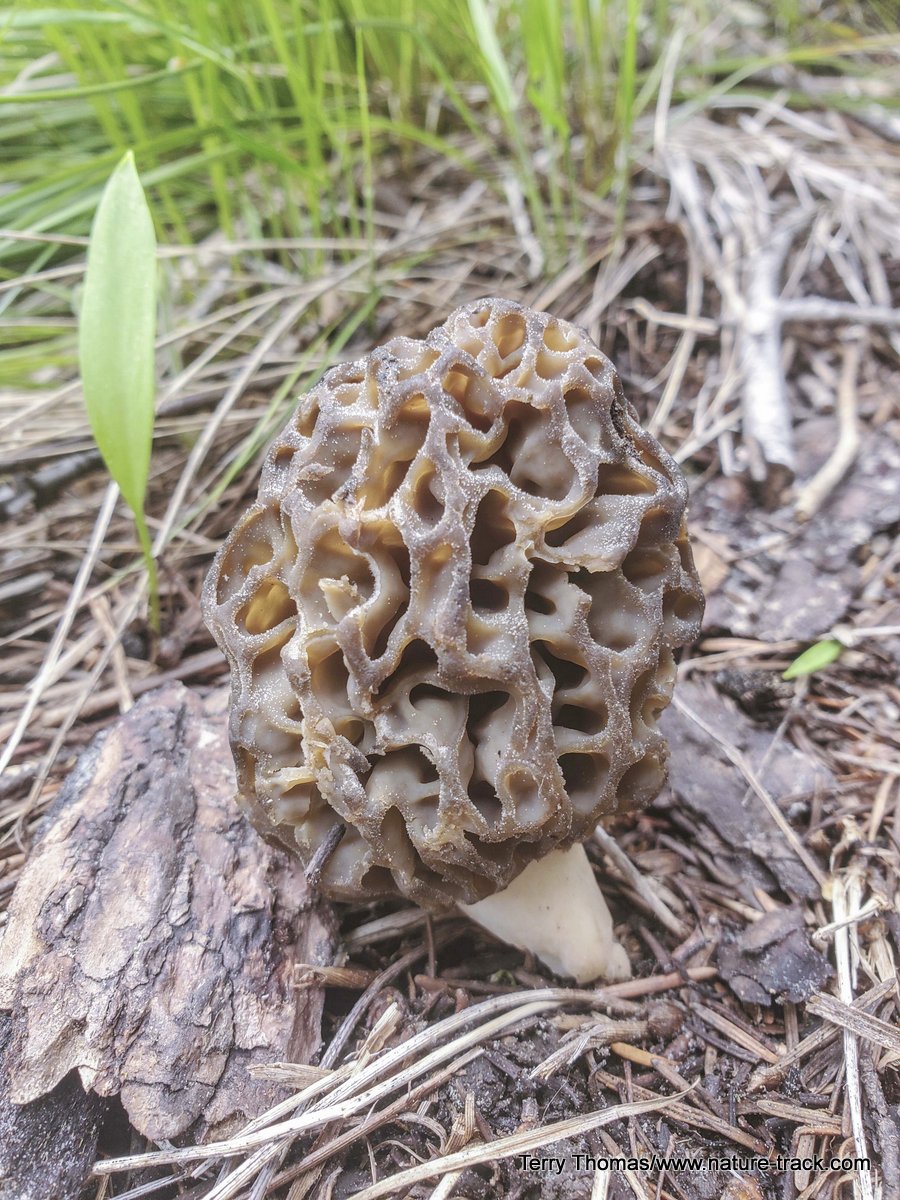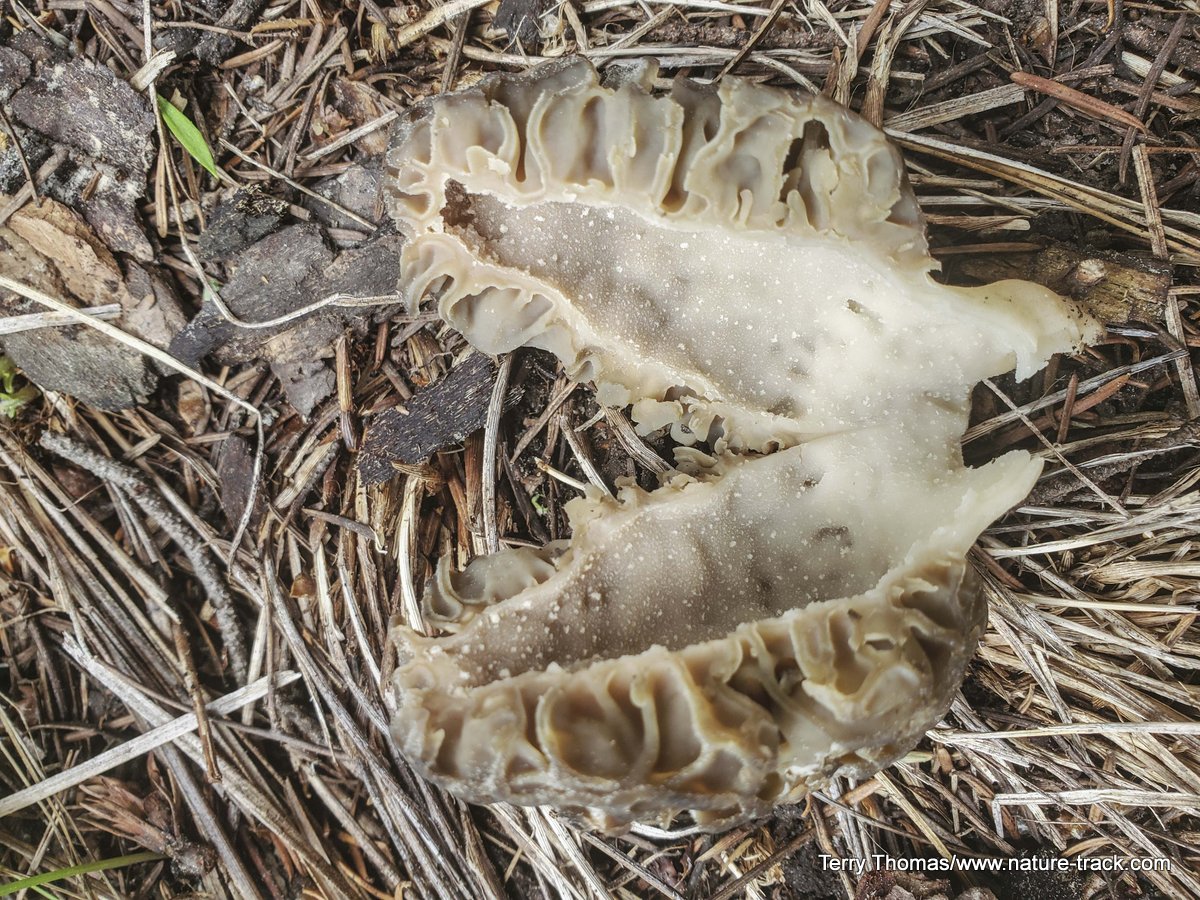Puffballs and Morels


Morel mushrooms, morchella spp., are considered by many mushroom foragers as the pinnacle of mushroom flavor. The photo on the right shows the hollow center of a morel, a key diagnostic for identification.
I have seen giant puffball mushrooms in Idaho, but I didn’t know what I was looking at. I have always found them when they are fully developed and have had great fun helping them disperse their billions of spores by stomping on them to see the cloud of spores they produce. It never dawned on me that these were the same puffballs that foragers rave about.
There are a number of species of giant puffballs and all of them are edible. One found in the Rocky Mountains, including southern Idaho, is the Western Giant Puffball, Calvatia boonia. This puffball can get huge, but is best harvested when younger.
Puffballs look like large round or oval blobs. The outside can be quite variable though so the secret to identifying a puffball of any kind is to cut it open. It should be very white, solid and with NO gills whatsoever. There is one look-alike, the deadly amanita, that hides its gills when young and you have to cut it open to see them, down near the stem.
As puffballs age, they begin to turn yellow or green inside. These are past their prime and will cause severe gastrointestinal distress if eaten.
Puffballs can last several days if refrigerated, but leaving them on the counter will cause them to rot into a stinky mess quickly. There are lots of recipes on line for how to use puffballs, how to freeze them and how to dry them. I found this one, https://foragerchef.com/puffball-mushrooms/, interesting and it has a lot of good advice on how to prepare puffballs.
Puffballs can be found anytime during the summer and fall. They tend to prefer open fields and disturbed sites, likely places where their spores have a better chance of developing. They feed on dead organic matter, but unlike chicken of the woods mushrooms, they do not live on living or dead trees.
Finally, the king of all mushrooms, is the morel, morchella spp., of which there are at least 45 species worldwide, with another 35 or so that taxonomists have yet to agree on. It is so popular that there is even a National Morel Mushroom Festival, held every spring for the past 100 years in Boyne City, Michigan. This mushroom is so prized that a pound of dried ones may cost $200.
It seems fitting that this gift of the woods should be easy to recognize and it is. To me, the morel looks like something out of a Lord of the Rings movie. Its cap is long and often triangular-shaped with an irregular honey-combed appearance due to an uneven network of ridges and corresponding pits.
Morel foraging season is a short springtime-only event. As soil, about four inches below the surface, warms to 55 degrees F., morels begin fruiting. This only lasts until soil temperatures reach 62 degrees F. That makes the timing somewhat variable, but mid to late May is likely close to an average. The photos above were taken on June 5, in Island Park.
There are some morel look-alikes so paying attention to detail is still important, despite their classification as one of the “foolproof four.” First, morels are hollow, right down to the stems. Stem and cap appear to be one continuous unit. The caps of true morels are attached to the stem at, or near the base of the cap. Many look-alikes attach near the top of the cap.
One interesting fact about morels and most other edible mushrooms is that they can make you very sick if eaten raw or undercooked. And that is a good reminder that although the “foolproof four” are a great way to get started into mushroom foraging, education and the help of an experienced forager are still necessary. Again, foragerchef.com has some good suggestions for preparation and preservation of morels.
I plan to get brave this year and see if I can try some of the bounty the woods and fields have to offer in the form of mushrooms. Hopefully, I will be around next winter to tell about it!
Help Idaho Wildlife
When we traveled across the state in October 2017, most of the vehicles we saw using the wildlife management areas did not have wildlife plates. Buying wildlife plates is a great way for non-hunters and hunters alike to support wildlife-based recreation like birding.
C'mon folks, let's help Idaho's wildlife by proudly buying and displaying a wildlife license plate on each of our vehicles!
See below for information on Idaho plates. Most states have wildlife plates so if you live outside Idaho, check with your state's wildlife department or vehicle licensing division for availability of state wildlife plates where you live.
And tell them that you heard about it from Nature-track.com!

Wildlife License Plates
Great news! as of 2024, there are three NEW designs for license plates. They still are bluebird, cutthroat trout and elk, but they are beautiful.
Idaho Wildlife license plates provide essential funding that benefits the great diversity of native plants and wildlife that are not hunted, fished or trapped—over 10,000 species or 98% of Idaho’s species diversity. Game species that share the same habitats (such as elk, deer, antelope, sage-grouse, salmon, trout) also benefit from these specialty plates.
No state tax dollars are provided for wildlife diversity, conservation education and recreation programs. Neither are any revenues from the sale of hunting or fishing licenses spent on nongame species. Instead, these species depend on direct donations, federal grants, fundraising initiatives—and the Idaho Wildlife license plates.
Both my vehicles have Bluebird Plates. I prefer the bluebird because the nongame program gets 70 percent of the money from bluebird plates, but only 60 percent of the money from elk and trout plates - 10 percent of the money from elk plates supports wildlife disease monitoring and testing programs (to benefit the livestock industry) and 10 percent from cutthroat plates supports non-motorized boat access.
Incidentally, in 2014, the Idaho Legislature denied the Department of Fish and Game the ability to add new plates or even to change the name of the elk and cutthroat plates (very specific) to wildlife and fish plates, a move that would have allowed for changing images occasionally and generating more revenue. It would seem that they believe that we Idahoans don't want a well funded wildlife program.
I think it is time we let the Legislature know that Idahoan support wildlife funding and that we would like to see these generic plates come to fruition.

"WOW. What a phenomenal piece you wrote. You are amazing." Jennifer Jackson
That is embarrassing, but actually a fairly typical response to my nature essays. Since The Best of Nature is created from the very best of 16 years of these nature essays published weekly in the Idaho Falls Post Register (online readership 70,000), it is a fine read. It covers a wide variety of topics including humorous glimpses of nature, philosophy, natural history, and conservation. Readers praise the style, breadth of subject matter and my ability to communicate complex and emotional topics in a relaxed and understandable manner.
Everyone can find something to love in this book. From teenagers to octogenarians, from the coffee shop to the school room, these nature essays are widely read and enjoyed.
Some of the essays here are my personal favorites, others seemed to strike a chord with readers. Most have an important message or lesson that will resonate with you. They are written with a goal to simultaneously entertain and educate about the wonderful workings of nature. Some will make you laugh out loud and others will bring a tear to the eye and warm your heart.
Readers Write:
"You hit a home run with your article on, Big Questions in Nature. It should be required reading for everyone who has lost touch with nature...great job!" Joe Chapman
"We enjoyed your column, Bloom Where Planted. Some of the best writing yet. The Post Register is fortunate to have your weekly columns." Lou Griffin.
To read more and to order a copy, click here or get the Kindle version
Copies are also available at:
Post Register
Island Park Builders Supply (upstairs)
Barnes and Noble in Idaho Falls
Harriman State Park, Island Park
Museum of Idaho
Valley Books, Jackson Wyoming
Avocet Corner Bookstore, Bear River National Wildlife Refuge, Brigham City, Utah
Craters of the Moon National Monument Bookstore, Arco, Idaho